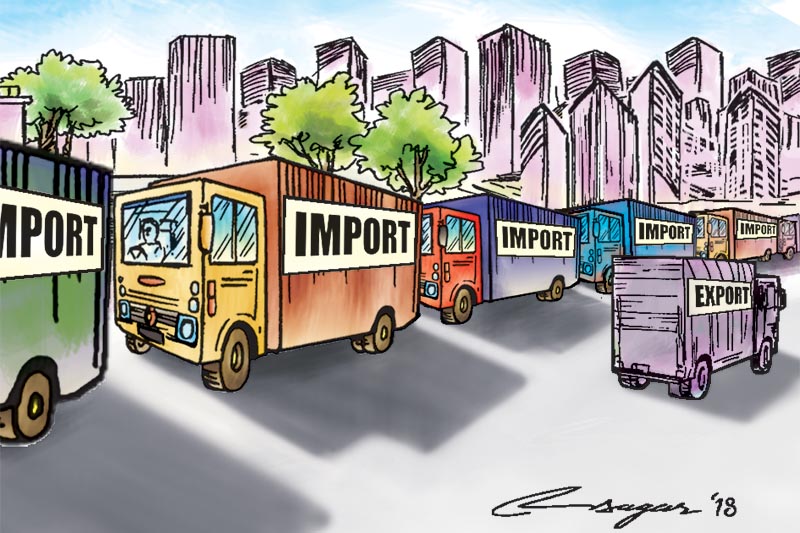Yawning trade deficit: It’s hurting our economy
To bridge the yawning trade gap, Nepal must act now to expand production of local products, provide subsidies to the farmers, create conducive environment for the establishment of industries and prudently utilise the trade facilities
Nepal is one of the economically struggling sovereign states. The country is lagging far behind due to persistent political upheavals, underdeveloped manufacturing industries and lack of infrastructure. Nepal’s foreign trade is insignificant as the nation exports significantly less in comparison to the bulk of imports – the imports surpass exports by multiple folds. As a result, the yawning trade deficit is hurting the country’s economy.
Though the government of Nepal established the Trade and Export Promotion Centre (TEPC) as a national trade promotion organisation in 2006, there has not been any perceptible progress in international trade. The imports are drastically increasing every year, while export is shrinking. Nepal hence has become an import-based economy.
Nepal imports products from more than 100 nations and exports products to about 135 nations and 175 economic zones across the globe. India and China are the major import partners of Nepal with 65.1 per cent and 12.6 per cent of total imports from respective nations (TEPC, 2018).
On the other hand, India, the USA, Turkey, Germany, the UK, and China are the major export partners of Nepal with 56.6 per cent, 11.2 per cent, 6.4 per cent, 3.9 per cent, 3.4 per cent, and 3 per cent of total exports from the respective countries (TEPC, 2018).
High-speed diesel, MS Billet, Gold (semi-manufactured forms), cement clinkers, and LPG were the top five imports of Nepal in 2017 with their respective import value of 7.1 per cent, 4.7 per cent, 2.6 per cent, 2.5 per cent, and 2.3 per cent of total imports (TEPC, 2018).
Likewise, the top five exports of Nepal in 2017 were carpet, knotted wool or fine animal hair, big cardamom (neither crushed nor ground), yarn of polyester, mixture of juices, and woven fabric with the respective export value of 9 per cent, 5.8 per cent, 5.4 percent, 4.2 per cent, and 3.9 per cent (TEPC, 2018). According to TEPC (2018), in 2017 Nepali exports amounted to around Rs 78 billion, while the imports stood at around Rs 1.5 trillion.
Accordingly, in 2017 the ratio of import to export stood at 13.6037. Similarly, the trade data of 2014, 2015 and 2016 reveals that the import to export ratio stood at 8.5429, 8.9836 and 12.8228 respectively. With import to export ratio increasing, the country is grappling with widening trade deficit.
Nepal has been a member of World Trade Organisation (WTO) since April 23, 2004. Most of the world’s leading economies have provided duty-free quota-free entry to certain Nepali products.
In February 2016, the US signed Trade Facilitation and Trade Enforcement Bill (TFTEB) into law to extend special trade preferences to Nepal. Nations such as Japan, Canada, South Korea and Turkey are providing duty-free access to Nepali products.
Enhanced Integrated Framework by the WTO has supported the enhancement of Nepali economy. It has supported in cardamom production and has granted $20 million for pashmina industry.
Nepal and India entered into a treaty for the imposition of zero per cent tariff to Nepali products exported to India. China has been providing duty-free quota-free access to 8,030 products, which include cooking utensils, footwear, printing papers, medicinal oil, plastic products and beauty products.
Despite ample trade facilities such as duty-free quota-free access to Nepali products in the US and China, Nepal is not concentrating on enhancing exports.
Unstable governments, lack of infrastructure, products sans quality standards, limited production of goods, technological backwardness, deficiency of business confidence, and lack of time-based delivery are some of the major hindrances to the growth of export of Nepali products.
The plight of agro-based Nepali economy is apparent as the nation is currently importing cereals, grains and other agricultural products from India, Brazil and Australia.
Nepali products are disappearing while imported products are occupying the markets. This paints a bleak picture for Nepal’s agriculture sector. Agriculture is the mainstay of Nepal’s economy, with its contribution in the national gross domestic product hovering around 30 per cent.
Majority of the fast-moving consumer goods supplied to Nepali market are from India and China. Rapidly rising imports and dwindling exports pose a severe threat to an economy.
If this situation persists, there shall be no domestic products in the Nepali market. Consequently, the foreign currency reserve of the nation will deplete over time, as rising exports will mean the country will be paying more in foreign currency. The persistence of this phenomenon for a decade or two might compel Nepal to succumb to economic imperialism.
To avoid such formidable future consequences, Nepal must expand the production of local products, provide subsidies to the farmers, create an environment conducive to the establishment of industries, prudently utilise the trade facilities and must focus on Import Substitution Industrialisation (ISI).
Nepal must formulate strict laws against the production of goods not maintaining the standards, exploitation of child labour, and breach of contracts so that the global market could trust Nepal, and buy Nepali products without any suspicion.






